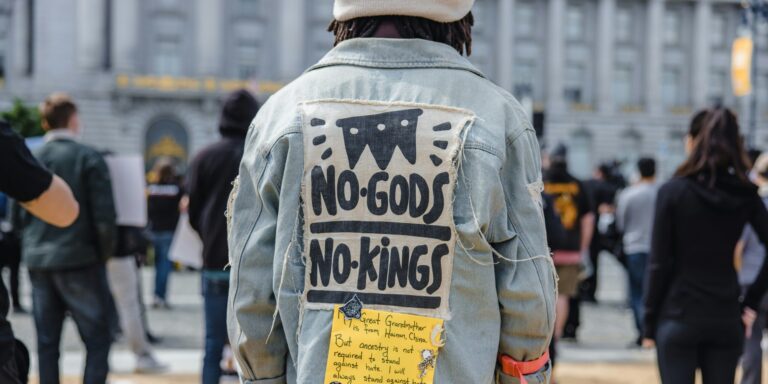On October 18, 2025, protests known as the “No Kings” demonstrations unfolded across the United States, marking a significant moment of political resistance to the Trump administration. With over 2,700 events taking place in cities large and small, the protests were organized by a diverse coalition of over 200 groups, including well-known civil rights organizations such as the ACLU and progressive political advocacy groups like Indivisible. These protests served as an expression of frustration and alarm at the direction of the country under the Trump administration, with participants voicing concerns over immigration enforcement, civil liberties, and what they saw as the erosion of democratic norms.
The “No Kings” protests, in particular, symbolized the growing disillusionment with the administration’s policies, which many perceived as authoritarian and increasingly undermining fundamental democratic principles. Protesters gathered to raise their voices against the administration’s strict immigration policies, including the ongoing crackdown on undocumented migrants, the use of family separation as a deterrent at the border, and the continued rhetoric of fear surrounding immigration. For many, these actions were not just policy disagreements but a deep moral concern over the treatment of individuals and families, particularly in relation to human rights and the dignity of those affected by these policies.
At the core of the protests was a call to defend civil liberties, which activists felt were being systematically eroded. From concerns about surveillance and the curtailing of privacy rights to fears surrounding voter suppression and the manipulation of democratic processes, the protests reflected a widespread belief that the administration was threatening the foundational principles that have long upheld the U.S. democracy. For many involved, the protests were not only about opposition to specific policies but also a growing sense that the very essence of democratic norms—freedom of speech, the protection of rights, and the checks and balances within government—was under serious threat.
Although the protests were largely peaceful, the scale and scope of these events pointed to deepening political divisions within the country. With over 2,700 separate gatherings happening across the nation, from major cities to rural communities, it became evident that the concerns driving the protests were widespread. In many cases, protesters carried signs and banners with the slogan “No Kings,” symbolizing their rejection of what they saw as a shift toward autocracy and authoritarianism. The slogan itself encapsulated the belief that the U.S. government should be governed by the people, for the people, rather than by a single, powerful individual or group.
These protests also represented the rise of grassroots activism, a powerful force that has continued to shape the political landscape in the U.S. over the past several years. Many of the groups involved in the “No Kings” protests were longtime activists, involved in movements focused on racial justice, environmental protection, and economic inequality. But in 2025, these groups had come together under a shared sense of urgency regarding what they saw as the danger of authoritarianism and the fragility of democracy itself. This convergence of political movements demonstrated the power of coalitions to mobilize large groups of people around common causes, even in an era where political divisions are often deep and entrenched.
The use of digital tools to organize and amplify these protests further highlighted the changing nature of political activism. Social media platforms like Twitter, Facebook, and Instagram played a crucial role in spreading information about the protests and engaging new participants. These tools allowed activists to bypass traditional media channels and organize rapidly, enabling them to reach a wider audience and galvanize public support for the cause. The ability to harness online networks for offline activism was a key factor in the success of the “No Kings” protests, providing a model for how digital spaces can serve as a catalyst for real-world change.
The “No Kings” protests also underscored the increasing polarization within the country. While the demonstrations were overwhelmingly peaceful, they highlighted the growing divide between different segments of the population. For many, the protests represented a clarion call to defend democracy against what they saw as an increasingly authoritarian regime. On the other hand, there were those who viewed the protests as an unwarranted challenge to the legitimacy of a duly elected president. This division in perspectives reflected the broader ideological battles taking place in the U.S., where political discourse has become increasingly heated and contentious.
Despite the challenges posed by this political polarization, the “No Kings” protests were a powerful expression of collective action. They showed that, even in times of deep division, there is a willingness among many Americans to come together to defend the core values of the nation. The protests not only highlighted the specific grievances with the Trump administration but also served as a broader reminder of the strength and importance of grassroots movements in holding elected officials accountable.
In the weeks and months following the protests, the political discourse in the United States continued to be shaped by the events of October 18, 2025. While the protests did not lead to immediate policy changes, they left a lasting mark on the political landscape, signaling that there was a growing movement of citizens who were increasingly unwilling to stand by as what they considered to be authoritarian policies took hold. The “No Kings” protests were a reflection of a larger, ongoing struggle for the soul of American democracy—one that would continue to play out in the political arena as the nation moved closer to the 2026 presidential election.
In conclusion, the “No Kings” protests on October 18, 2025, were a resounding expression of political frustration and resistance to what many saw as the authoritarian tendencies of the Trump administration. With over 2,700 events across the country, the protests addressed concerns such as immigration, civil liberties, and the preservation of democratic norms. Through these demonstrations, a diverse coalition of groups made it clear that they would not stand idly by as they believed their fundamental rights were being undermined. As the protests highlighted the deep political divisions in the nation, they also underscored the power of grassroots activism and the role of ordinary citizens in shaping the future of their country.



